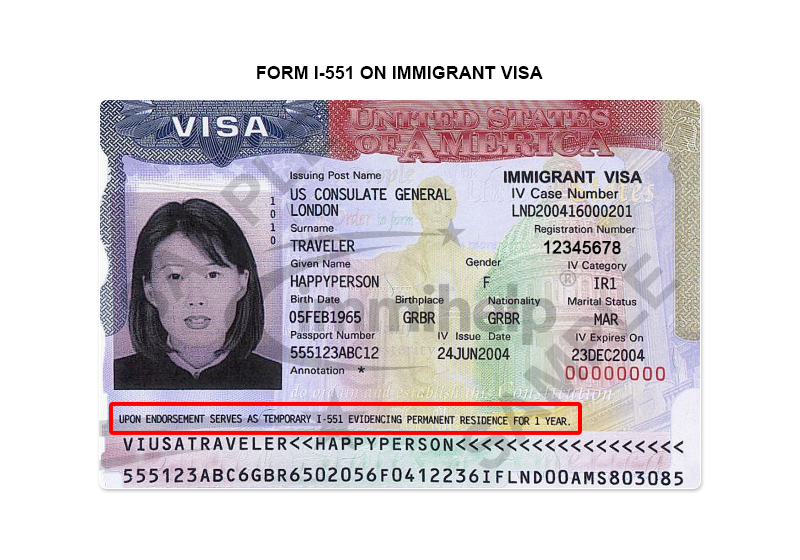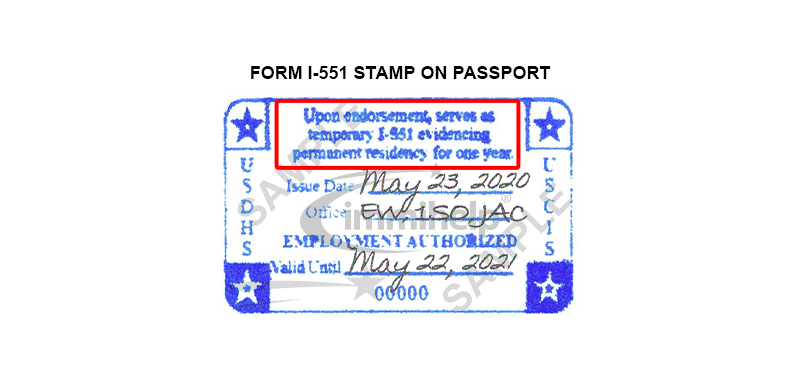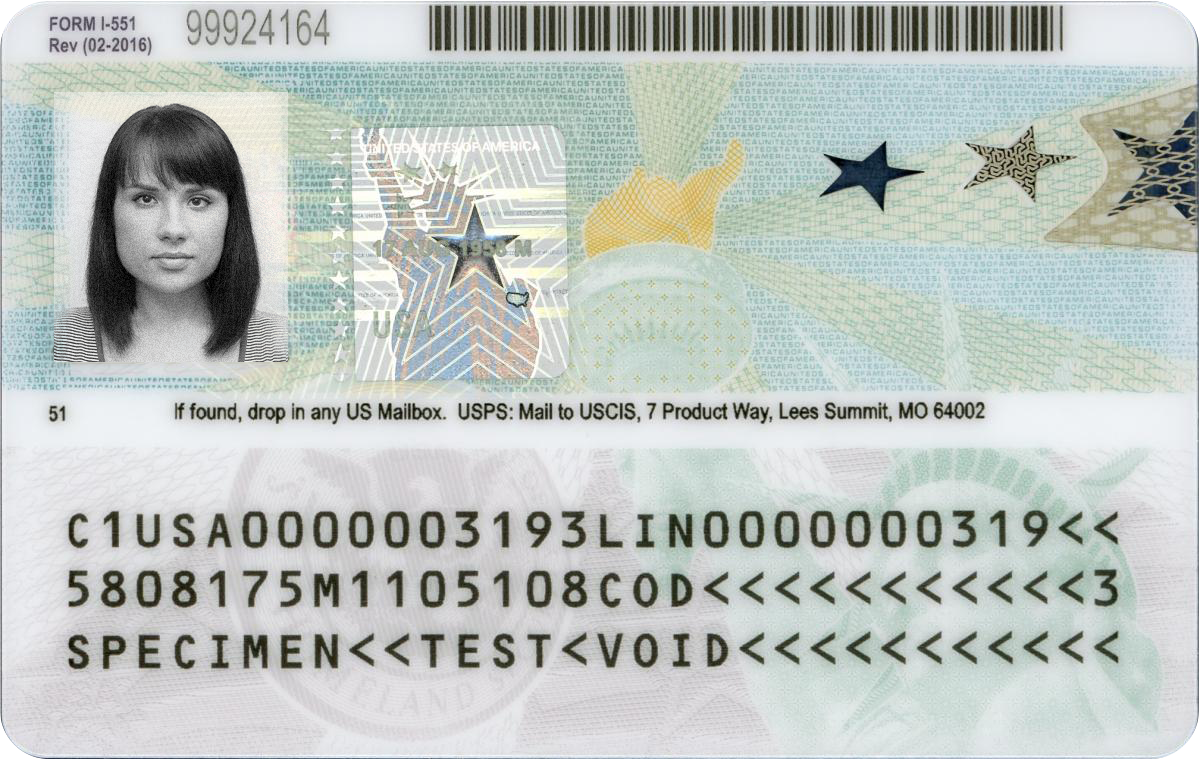Can I travel with I-551 stamp? That’s the burning question for many new permanent residents! This little stamp, your I-551, is your ticket to the American dream, but what about jetting off to see Grandma in Italy or hitting the beaches in Mexico? This guide breaks down everything you need to know about traveling internationally with your I-551 stamp, from airline procedures to customs chats, so you can plan your next adventure without a hitch.
We’ll cover the legal lowdown on your I-551, different types of stamps, and what documents you’ll need to pack. Think of it as your ultimate travel survival guide for green card holders. We’ll explore potential snags, share success stories, and even offer tips on navigating those tricky airport encounters. Get ready to conquer the world, one border crossing at a time!
Understanding the I-551 Stamp

The I-551 stamp, also known as the “Temporary I-551” or “admission stamp,” serves as evidence of lawful permanent resident status in the United States. Possessing this stamp carries significant legal implications, impacting an individual’s rights and responsibilities within the country. Understanding its nuances is crucial for navigating daily life and interacting with government agencies.
Legal Implications of Possessing an I-551 Stamp
Possession of a valid I-551 stamp grants the bearer the privileges and protections afforded to lawful permanent residents. This includes the right to work legally, access to government benefits (subject to eligibility requirements), and protection from deportation. However, it is crucial to remember that the stamp is temporary and serves as proof of status until the physical I-551 Permanent Resident Card (Green Card) is issued.
Misrepresentation or fraudulent use of the stamp can result in severe legal consequences, including fines and deportation.
Types of I-551 Stamps and Their Variations
While the I-551 stamp fundamentally signifies lawful permanent resident status, there can be slight variations depending on the circumstances of the individual’s immigration case. These variations may include differing wording or annotations. For example, some stamps might specifically mention conditional residency, reflecting a two-year conditional period associated with certain immigration categories (e.g., marriage-based green cards). Other stamps may indicate the individual’s specific admission category or any limitations on their permanent residency.
The exact wording on the stamp should be carefully reviewed.
Obtaining an I-551 Stamp: A Step-by-Step Guide
The I-551 stamp is not independently applied for; it is issued by U.S. Citizenship and Immigration Services (USCIS) or a port of entry officer as part of the process of becoming a lawful permanent resident. The steps involved vary depending on the individual’s immigration path, but generally, the process involves:
1. Filing an application for permanent residency
This involves submitting the appropriate forms and supporting documentation to USCIS, which will vary based on the individual’s immigration category.
2. Biometrics appointment
USCIS may schedule a biometrics appointment where fingerprints and a photograph are taken.
3. Interview (if required)
Depending on the immigration category, an interview with a USCIS officer may be necessary.
4. Approval and issuance of the I-551 stamp
Upon approval of the application, the I-551 stamp is placed in the individual’s passport or travel document at a USCIS office or a port of entry. The individual will then receive their official Green Card by mail at a later date.
Comparison of I-551 Stamp with Other Immigration Documents
The following table compares the I-551 stamp with other key immigration documents.
| Document | Purpose | Validity | Issuing Authority |
|---|---|---|---|
| I-551 Stamp (Temporary I-551) | Proof of lawful permanent resident status (temporary) | Until Green Card is issued | USCIS or Port of Entry Officer |
| I-551 Green Card (Permanent Resident Card) | Proof of lawful permanent resident status | 10 years | USCIS |
| Form I-797C, Notice of Action | Receipt notice confirming USCIS receipt of application | Until case is adjudicated | USCIS |
| Visa | Permission to enter the U.S. | Varies depending on visa type | U.S. Embassy or Consulate |
Travel Eligibility with an I-551 Stamp
An I-551 stamp, also known as a temporary resident card, grants the bearer admission to the United States. However, its implications for international travel are not always straightforward and depend heavily on individual circumstances and the issuing country’s immigration policies. While the stamp serves as evidence of lawful permanent resident status, it does not automatically guarantee smooth passage through all international borders.
Careful planning and understanding of potential restrictions are crucial for successful international travel.Travel restrictions associated with an I-551 stamp primarily stem from the temporary nature of the stamp itself. Unlike a physical green card, the I-551 stamp’s validity is limited, and its acceptance by foreign immigration authorities is not universally guaranteed. Furthermore, the stamp alone may not be sufficient proof of lawful status for some countries, necessitating additional documentation.
The specific travel restrictions encountered can vary greatly depending on the individual’s nationality, the country of intended travel, and the purpose of the visit.
Required Documents for International Travel with an I-551 Stamp
To mitigate potential travel complications, individuals possessing an I-551 stamp should carry a comprehensive set of documents beyond the stamp itself. This preparation significantly enhances the likelihood of a smooth travel experience. The necessary documentation may include, but is not limited to, a valid passport, a return or onward travel ticket, sufficient funds for the duration of the trip, and proof of accommodation.
In addition, a copy of the I-94 form (Arrival/Departure Record) can be beneficial, as it provides further evidence of lawful entry into the United States. Finally, providing a detailed itinerary to immigration officials can also help demonstrate the purpose and duration of the planned travel.
Potential Issues When Traveling with an I-551 Stamp
Several issues may arise when traveling internationally with an I-551 stamp. One common problem is the potential for delays or denial of entry at foreign airports or border crossings. Immigration officials in other countries may require additional documentation or clarification regarding the individual’s immigration status in the United States. Misunderstandings regarding the temporary nature of the I-551 stamp can also lead to difficulties.
Furthermore, some countries may have specific visa requirements for individuals holding temporary resident status, even if they possess an I-551 stamp. It is therefore crucial to research visa requirements well in advance of travel to avoid unforeseen complications.
Examples of Successful International Travel with an I-551 Stamp
While challenges exist, many individuals successfully travel internationally with an I-551 stamp. For example, a lawful permanent resident with an I-551 stamp traveling to Canada for a short family visit may experience no issues if they present their passport, I-551 stamp, and sufficient proof of return travel. Similarly, a person with an I-551 stamp and a valid visa for a specific country may experience smooth passage to that destination.
Success hinges on meticulous preparation, thorough research of the destination country’s visa requirements, and the presentation of comprehensive documentation to immigration officials. The key to a successful trip lies in proactive planning and preparedness.
Duration of Stay and Re-entry

The I-551 stamp, also known as a temporary resident card, grants individuals the privilege of residing in the United States. However, the duration of permissible stays outside the U.S. and the process of re-entry are crucial aspects that require careful understanding. Misinterpretations can lead to significant complications and potential immigration consequences.The permitted duration of stay outside the U.S.
with an I-551 stamp is not explicitly defined by a fixed timeframe. Instead, it’s generally understood that extended absences could raise questions about maintaining continuous residence. The length of an absence that might trigger scrutiny varies on a case-by-case basis and depends on factors such as the individual’s overall immigration history, the purpose of the travel, and the length of their U.S.
residency prior to the trip. Immigration officials assess each situation individually, considering the totality of circumstances.
Re-entry Procedures
Re-entering the U.S. with an I-551 stamp involves presenting the stamp, along with a valid passport, to a Customs and Border Protection (CBP) officer. The officer will review the documentation and may ask further questions regarding the purpose and duration of the trip abroad. Individuals should be prepared to demonstrate their continued ties to the U.S., such as employment, property ownership, or family connections.
Failure to provide sufficient evidence could result in delays or denial of entry. It is advisable to carry additional documentation supporting the individual’s continuous residence in the U.S., such as bank statements, lease agreements, or employment letters.
Consequences of Exceeding Permitted Stay
Exceeding the implied or perceived limits on the duration of stay outside the U.S. while possessing an I-551 stamp can have severe consequences. These can range from increased scrutiny at the port of entry, delays in processing, to a denial of entry and, in extreme cases, potential initiation of removal proceedings. The length of the absence and the reasons for it will heavily influence the outcome.
Continuous absences of considerable duration could be interpreted as abandonment of permanent resident status, leading to the loss of green card privileges.
Frequently Asked Questions Regarding Re-entry
Understanding the potential issues surrounding re-entry with an I-551 stamp is critical. The following points address common concerns.
- Question: How long can I stay outside the U.S. with an I-551 stamp before facing potential issues? Answer: There’s no set time limit. Extended absences may lead to questioning regarding the maintenance of continuous residence. The duration of acceptable absence is assessed on a case-by-case basis.
- Question: What documents should I bring when re-entering the U.S.? Answer: Bring your I-551 stamp, valid passport, and supporting documentation demonstrating continuous U.S. residency (e.g., employment letters, lease agreements, bank statements).
- Question: What happens if I am denied re-entry? Answer: Denial of re-entry can lead to further questioning, potential delays, and in serious cases, removal proceedings. Legal counsel should be sought immediately.
- Question: Can I travel internationally multiple times with an I-551 stamp? Answer: Yes, but each trip requires careful consideration of the potential implications of extended absences from the U.S.
Airline and Customs Procedures

Traveling internationally with an I-551 stamp requires careful preparation and understanding of the procedures involved with both airline personnel and customs officials. Failure to adequately prepare can lead to delays or even denied boarding. This section Artikels the necessary steps to ensure a smooth travel experience.
Pre-Travel Checklist for I-551 Stamp Holders
Preparing a comprehensive checklist before your journey is crucial. This minimizes potential issues at the airport and during immigration processing. The following items should be included in your pre-flight preparations.
- Valid Passport: Ensure your passport is valid for at least six months beyond your intended stay in the destination country.
- I-551 Stamp: Verify the I-551 stamp is clearly visible and undamaged. If there are any concerns about its legibility, contact USCIS before traveling.
- Return or onward travel ticket: Demonstrate proof of your intended departure from the destination country.
- Sufficient Funds: Have sufficient funds to cover your expenses during your stay, as you may be asked to demonstrate financial stability.
- Proof of Accommodation: Hotel reservations or a letter of invitation from your host can help establish your itinerary.
- Purpose of Travel Documentation: Depending on your purpose, supporting documentation such as a business letter, conference invitation, or tourist itinerary may be required.
- Copies of Important Documents: Make copies of your passport, I-551 stamp, and other crucial travel documents and keep them separate from the originals.
Interactions with Airline and Customs Officials
Interactions with airline and customs officials will vary depending on the specific airline and the country you are entering. However, maintaining a calm and respectful demeanor throughout the process is essential.
Example Questions and Appropriate Responses
Airline and customs officials may ask a variety of questions to verify your travel eligibility. Understanding potential questions and formulating appropriate responses is crucial for a smooth experience.
- Potential Airline Question: “May I see your passport and visa/I-551 stamp?” Appropriate Response: Politely present your passport and I-551 stamp, ensuring they are easily visible.
- Potential Customs Question: “What is the purpose of your visit?” Appropriate Response: Clearly and concisely state the purpose of your trip (tourism, business, etc.) and provide supporting documentation if necessary.
- Potential Customs Question: “How long will you be staying?” Appropriate Response: State the exact duration of your intended stay, aligning with your return ticket and any other relevant documentation.
- Potential Customs Question: “Where will you be staying?” Appropriate Response: Provide the address of your accommodation and any supporting documentation (hotel reservation, invitation letter).
Best Practices for Smooth Travel
To ensure a smooth travel experience, follow these best practices:
- Arrive Early: Allow ample time for check-in and security procedures, especially given the potential for additional scrutiny.
- Be Prepared: Have all necessary documents readily accessible and organized. This demonstrates preparedness and efficiency.
- Be Respectful and Courteous: Maintain a calm and respectful attitude when interacting with airline and customs officials.
- Be Honest and Accurate: Provide truthful and accurate answers to all questions posed by officials.
- Understand Your Rights: Familiarize yourself with your rights as a traveler and know that you have the right to request clarification if necessary.
Specific Scenarios and Case Studies: Can I Travel With I-551 Stamp
Understanding the practical implications of traveling with an I-551 stamp requires examining diverse scenarios and considering the potential impact of nationality and individual circumstances. This section analyzes various travel experiences, highlighting potential challenges and outlining strategies for successful navigation of international travel with this temporary residency document.
Travel Experiences Based on Nationality
The experience of traveling with an I-551 stamp can vary significantly depending on the traveler’s nationality and the relationship between their home country and the United States. Citizens of countries with strong diplomatic ties to the U.S. might encounter fewer difficulties than those from countries with more complex or strained relationships. For example, a Canadian citizen with an I-551 stamp might experience smoother processing at U.S.
airports and border crossings compared to a citizen from a country subject to more stringent immigration scrutiny. This difference stems from pre-existing bilateral agreements, streamlined immigration processes, and varying levels of perceived risk associated with different nationalities. The processing time, level of questioning, and overall experience can be markedly different.
Hypothetical Scenarios and Potential Outcomes
Consider a hypothetical scenario involving a Mexican national, Maria, holding an I-551 stamp, traveling to Canada for a family visit. Maria’s I-551 stamp, while proving her lawful permanent resident status in the U.S., does not automatically grant her visa-free entry to Canada. She would need to secure the appropriate Canadian visa or travel authorization before her trip. Failure to do so could result in her being denied boarding or entry into Canada.
Conversely, a British citizen, John, with an I-551 stamp, traveling to the UK, might find the process simpler due to the established travel agreements between the UK and the U.S. However, he should still carry his I-551 stamp and passport to avoid any potential complications.
Travel Difficulties and Suggested Solutions, Can i travel with i-551 stamp
Imagine a scenario where David, a South Korean national with an I-551 stamp, experiences difficulties at a U.S. airport upon his return from a trip to South Korea. Airport officials might request additional documentation beyond his I-551 stamp and passport to verify his identity and legal residency. In this situation, David should remain calm, cooperate fully with officials, and provide any requested supporting documentation, such as his I-797C notice of action or other evidence of his legal presence in the U.S.
He could also explain the purpose of his trip and provide proof of his ties to the United States, such as employment contracts or property ownership. If the issue persists, he should politely request to speak to a supervisor or immigration officer.
Addressing Issues at Airports or Border Crossings
A detailed and organized approach is crucial when facing difficulties at airports or border crossings. Individuals should always carry their passport, I-551 stamp, and any other relevant immigration documents. They should also maintain copies of these documents separately, in case of loss or damage. A calm and respectful demeanor is essential. Clear and concise communication with officials, providing all necessary information promptly and accurately, is vital.
If an issue arises, documenting the interaction, including the names and badge numbers of the officials involved, can be beneficial for future reference. If denied entry, individuals should seek legal counsel to understand their options and appeal the decision, if appropriate. The process of appealing a denial of entry can be complex and requires legal expertise.
So, can you travel internationally with your I-551 stamp? Absolutely! But remember, preparation is key. Knowing the rules, having the right paperwork, and understanding potential questions from airline and customs officials can make all the difference in a smooth and stress-free travel experience. With a little know-how, you’ll be exploring the globe with your I-551 in hand, ready to make some amazing memories.
Now go forth and travel!
Answers to Common Questions
What if my I-551 stamp is expiring soon?
Renew your green card ASAP! Traveling with an expired stamp can cause major problems.
Can I use my I-551 stamp for travel within the US?
While it proves your residency, a driver’s license or state ID is generally preferred for domestic travel.
What if I lose my I-551 stamp while traveling?
Contact the nearest US embassy or consulate immediately. They can help you get a replacement.
Do I need a visa along with my I-551 stamp?
It depends on your nationality and destination. Check visa requirements for your specific travel plans.






